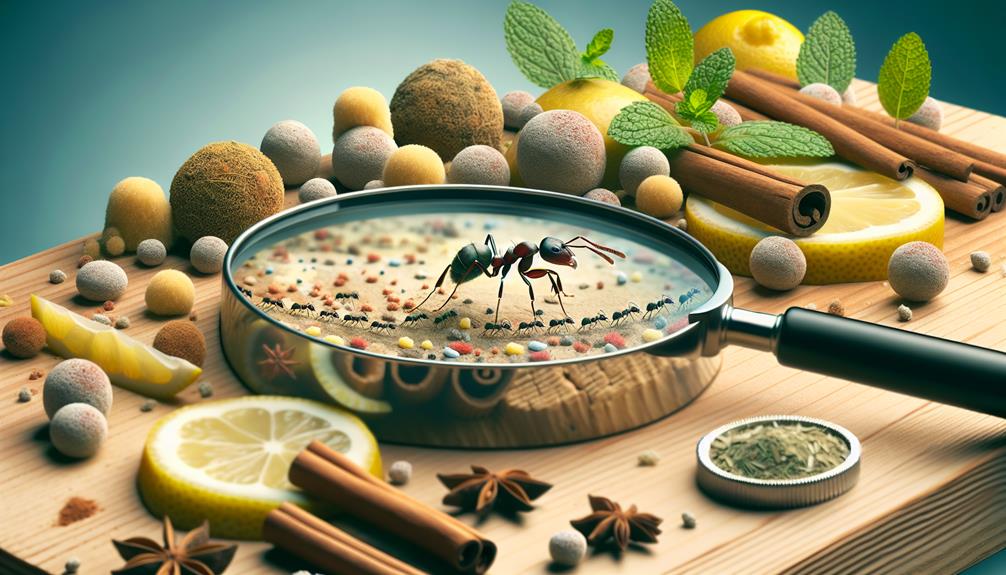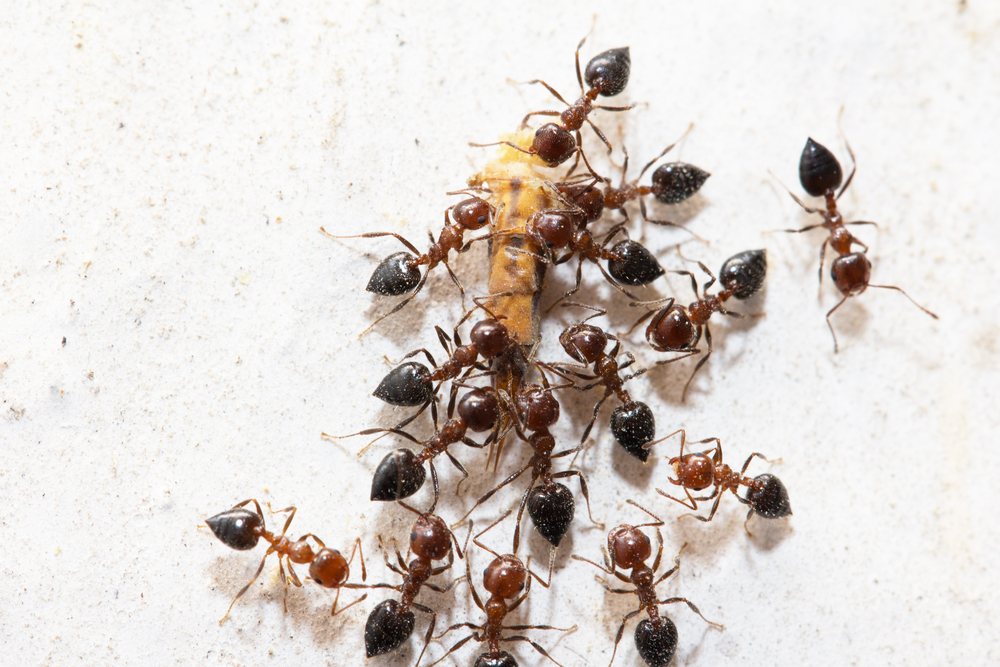As the sun rises, the birds chirp, and the flowers bloom, so too do ants begin their relentless invasion into your home. You’ve likely encountered these persistent pests marching in a line towards the tiniest crumbs on your kitchen counter or forming a colony in a corner of your garden.
Dealing with an ant invasion requires more than just a quick fix; it necessitates understanding their behavior, identifying their entry points, and mastering both natural and chemical strategies to keep them at bay. In the following discussion, you’ll discover effective ways to repel these unwelcome guests, from simple home maintenance tips to outdoor ant control methods and when it’s time to seek professional assistance.
But first, let’s explore why ants are attracted to your home in the first place and how you can use this knowledge to your advantage.
Key Takeaways
- Ants communicate through pheromones and have a hierarchical structure.
- Weather changes can drive ants indoors, and common entry points include cracks, window frames, and doorways.
- Natural repellents like essential oils can be used to create barriers and DIY traps with borax can lure ants.
- Regular home maintenance, such as cleaning, storing food properly, and repairing leaks, can help deter ants.
Understanding Ant Invasion

To effectively manage ant infestations, it’s crucial to first comprehend their complex social structures and behaviours, which drive their interactions with their environment and each other. Ant communication and colony dynamics are foundational to understanding these intricate societies. You’re stepping into a world where each ant plays a role, contributing to the survival of their colony. It’s a system built on efficiency and cooperation.
Ants communicate through chemicals known as pheromones, which are pivotal in their world. These chemical signals guide them to food, alert them to danger, and help maintain order within the colony. Imagine being part of a community where everyone knows exactly what to do and where to go, purely based on these invisible signals. It’s this level of organization that you’re up against when dealing with an ant infestation.
Understanding colony dynamics is equally critical. Ant colonies operate with a single or sometimes multiple queens, workers, and, at certain times of the year, winged reproductives. Each member has a distinct role, from foraging for food to protecting the nest. Recognizing these roles can help you identify the most effective strategies for managing ant populations.
Identifying Entry Points
Identifying the specific entry points ants use to invade your home is a critical step in managing an infestation effectively. By understanding where these tiny invaders gain access, you’re better equipped to thwart their attempts and protect your space.
Weather influences play a significant role in ant behaviour; changes in temperature and humidity can drive ants indoors to seek refuge and resources. Thus, it’s essential to scrutinize areas where ants might exploit these environmental shifts to enter your home.
Pay close attention to foundation cracks, window frames, and doorways, as these are common entry points. Additionally, utility lines and branches touching your home can serve as bridges for ants. Conducting a thorough inspection during different weather conditions can reveal entry points that mightn’t be obvious in stable weather.
Colony size also affects where ants choose to enter. Larger colonies often disperse their members more widely, leading to multiple entry points. Identifying and sealing these entrances can significantly reduce the number of ants making their way inside.
Natural Repellents

Several natural repellents have demonstrated efficacy in deterring ants, leveraging the insects’ aversive reactions to specific substances. Among these, essential oils stand out for their potent deterrent effect. Compounds like peppermint, tea tree, and eucalyptus oils not only emit strong aromas that ants find repulsive but also disrupt their olfactory navigation. By strategically placing a few drops of these oils near entry points and along trails, you’re not just masking scents that attract ants; you’re actively creating barriers that repel them.
DIY traps, utilizing the principles of attraction to entrap, offer another layer of defense. A simple yet effective trap can be made by mixing borax with a sweet substance like sugar water. This concoction, when placed in shallow containers along ant trails, lures them with its sweetness while the borax acts as a slow-acting poison, ensuring they carry it back to the colony. This method, though a bit more aggressive, aligns with the natural approach by using substances that are less harmful to the environment and non-target organisms compared to synthetic pesticides.
Chemical Solutions
While natural repellents offer an eco-friendly approach to ant control, there are instances where more immediate and potent solutions are necessary, leading us to explore chemical options. Delving into this realm requires a deep understanding of both the safety precautions and application methods that ensure effectiveness while minimizing risks to you and your environment.
Safety precautions are paramount when handling chemical solutions. You’ll need to wear protective gear, such as gloves and masks, to avoid direct contact with these substances. It’s also crucial to ensure that areas treated with chemicals are kept out of reach of children and pets, safeguarding their well-being.
The application methods vary depending on the chemical formulation. Baits, for instance, are strategically placed along ant trails and near entry points, offering a discreet yet powerful means to eliminate colonies. Sprays, on the other hand, provide immediate contact killing but require careful targeting to avoid non-target impacts. Gel formulations allow for precise application in cracks and crevices, directly hitting the nests.
Understanding these chemical solutions’ intricacies fosters a sense of belonging among those of us committed to maintaining a pest-free environment. By mastering these methods, you’re equipped to tackle ant invasions effectively, ensuring your home remains a sanctuary for you and your loved ones.
Home Maintenance Tips

To effectively prevent ant infestations, it’s essential to incorporate regular home maintenance practices that target potential entry points and attractants. Establishing consistent cleaning routines plays a pivotal role in deterring ants. By doing so, you’re not just preserving the sanctity of your home but also joining a community of vigilant homeowners who prioritize a pest-free environment.
Firstly, focus on eliminating food sources that attract ants. Ensure that your kitchen counters, floors, and cabinets are free from crumbs and spills. This involves sweeping, mopping, and wiping down surfaces daily. Store food in sealed containers and dispose of garbage regularly to minimize odors that may lure ants.
Appliance maintenance is equally crucial. Inspect and clean appliances regularly, especially those that come into contact with food, such as refrigerators, ovens, and toasters. Look for moisture buildup or leaks around your dishwasher and refrigerator, as ants are attracted to water sources. Repairing leaks promptly not only prevents water damage but also discourages ant colonies from establishing near these moisture-rich areas.
Outdoor Ant Control
How can you extend your ant control efforts beyond the confines of your home to the outdoors, where these pests originate? Understanding the behavior and ecology of different ant species is crucial in outdoor ant control. Each species has unique traits that influence their habitat preferences, foraging patterns, and colony size. By identifying these characteristics, you can adopt a more targeted approach to managing their populations.
For instance, some species might prefer nesting in moist, shaded areas, while others thrive in dry, sunny spots. This knowledge enables you to modify the environment to make it less inviting for them. Reducing standing water, clearing debris, and maintaining vegetation can significantly deter ant colonies from establishing themselves.
Moreover, considering the colony size is essential when selecting the appropriate control methods. Larger colonies may require more aggressive tactics, such as baiting systems that workers carry back to the nest, impacting the entire colony. Conversely, for smaller infestations, direct treatment of nests with insecticides might suffice.
Incorporating these strategies, grounded in a deep understanding of ant ecology, fosters a sense of belonging among community members, as everyone works together towards a common goal: keeping outdoor spaces ant-free.
Professional Pest Assistance

After implementing these outdoor ant control strategies, you might still find that ant populations persist, suggesting it’s time to seek professional pest assistance. When you’re facing an ant invasion, the complexities of their colonies and the potential health risks they pose necessitate a deeper understanding and more advanced tactics than the average homeowner possesses.
Engaging professionals in pest control offers you access to their expertise in identifying ant species, understanding their behavior, and employing targeted solutions that are both effective and environmentally conscious. A detailed cost analysis often reveals that investing in professional services can be more economical in the long run. Professionals can implement strategies that prevent reinfestation, saving you money and time that would otherwise be spent on repeated, less effective treatments.
Moreover, considering health risks is paramount. Certain ant species can carry pathogens or exacerbate allergies and asthma. Professionals are equipped with the knowledge and tools to handle these risks safely, ensuring your home remains a safe haven for you and your family.
Prevention Strategies
While engaging professionals is an effective course of action, adopting preventive measures can significantly reduce the likelihood of ant infestations in your home. The cornerstone of these measures is kitchen cleanliness. An ant’s primary motivation for entering your space is to find food. By maintaining a clean kitchen, you’re removing the ants’ incentive to invade. This involves promptly cleaning spills, especially of sugary substances, and ensuring that crumbs and food residues aren’t left on counters or floors.
Equally crucial is the method of food storage. Ants have a remarkable ability to find even the smallest food sources. Therefore, storing food in airtight containers isn’t just recommended; it’s essential. This includes pet food, which often goes overlooked.
Implementing these strategies creates an environment that’s inhospitable to ants. It’s about building a collective defense against pests, making your home a fortress that ants can’t penetrate. This not only wards off ant invasions but fosters a sense of community and belonging among household members, united in the quest for a clean, ant-free home.
You may also enjoy reading this article
Was This Article Helpful?
- Please provide feedback and comments to help us improve our content.
- Share your experiences and any additional tips you have for dealing with pests.
Share this Post



